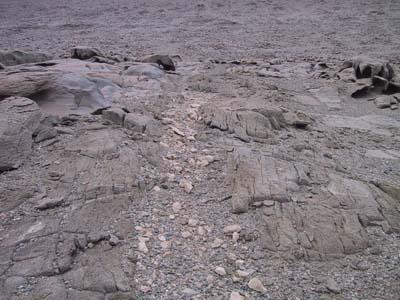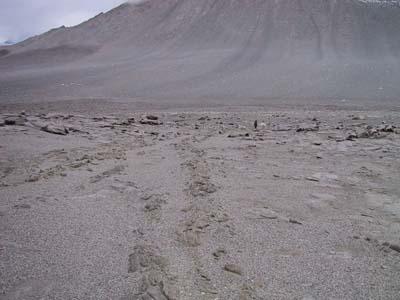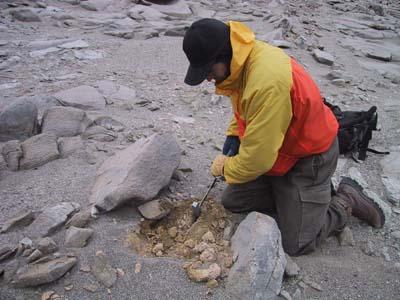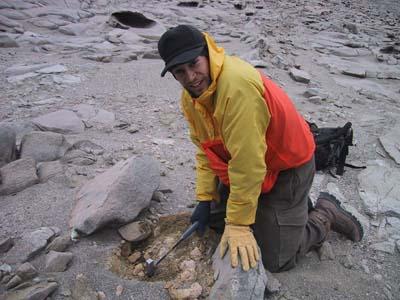
|
12 January, 2003Granite Dikes of Bull Pass It's Sunday so we'll take the day off by splitting into three groups of two and work on individual geology projects in the local area. Taber and I set off to do a reconnaissance of the East Wall of Bull Pass to get an idea of the locations of the major granite dikes that work their way up to the basement sill. The chemical and physical nature of these dikes are largely unknown and we will return in the future to collect more samples which can be analyzed back at the John's Hopkins Lab and other places. Amanda and Bruce are closer to camp investigating the relationship between vertical rib-like structures and the basement sill. Sarah and Karina are on the West Wall investigating segregations. For Taber and I we find a number of granite dikes about two miles north of camp. We record the GPS positions, direction, and thickness. The further north we go the wider the dikes become. We decide to collect samples from one major dike and will bring back seven sample bags that will eventually be sent back to McMurdo awaiting shipment to the United States. For each sample, we systematically record the elevation, position, and orientation of the dike the samples were taken from. Taber points out the importance of certain crystals that form in the granite. Igneous rock that cools quickly generally has small crystals the size of grains of sugar. When some of the dolerites are broken in half to examine the texture and crystals they appear to have the consistency and size of sugar except that the color is a rich gray. Larger crystals normally mean that the molten rock took longer to cool, thus the crystals "grew" larger in the rock. Some of the orthopyroxene (OPX) crystals we saw were as big as 2cm (a little less than an inch) long. These OPX crystals didn't form when the magma cooled at the surface but rather grew deeper in the earth and were transported by magma to the surface later. The samples we collected today as well as samples that will be collected in the upcoming weeks will be analyzed chemically by a variety of ways. An ion probe can discern certain elements as well as viewing thinly cut samples through a microscope with polarized light, and by using a mass spectrometer. One of the fundamental questions that will be looked at is whether the chemical composition of the granite changes as it goes up the mountain. The physical properties such as the melting point of the granite will also be checked. Antarctic Tidbits: - Antarctica's ice is so heavy that it deforms the South Pole. - The continent of Antarctica has been at the South Pole for only 100 million years. - Military activities of all countries are banned in Antarctica. Source: http://www.exploratorium.edu/origins/antarctica
Contact the TEA in the field at . If you cannot connect through your browser, copy the TEA's e-mail address in the "To:" line of your favorite e-mail package. |









